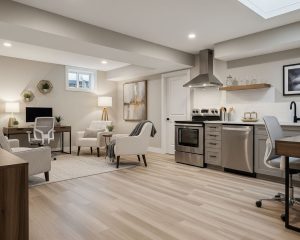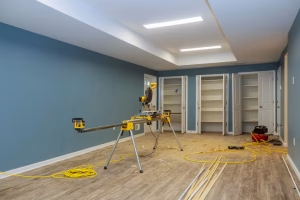When homeowners in Edmonton consider updating their homes, one of the first questions they face is whether they should renovate or remodel. The distinction matters because it affects planning, permits, timelines, and the professionals you hire. This article explains the difference between renovation vs remodel, lays out practical examples for kitchens, bathrooms, basements, and whole-house work, and offers clear guidance on choosing the right approach for your property. We also explain permit and code considerations specific to Edmonton and how Steadfast Constructions Ltd. can support a compliant, efficient project.
What does “Renovation vs Remodel” mean?
At a basic level, renovation and remodel are related but different actions:
- Renovation: Work that refreshes or restores an existing space without substantially changing its footprint or primary function. Examples include replacing finishes, updating fixtures, improving insulation, or refreshing cabinetry. Renovations preserve the basic layout and use of the space while improving the condition and appearance.
- Remodel: Work that changes the layout, structure, or primary use of a space. Remodeling often involves moving walls, reconfiguring plumbing or electrical systems, and altering how a room is used. Converting a basement into a legal secondary suite or changing a small bathroom into a full ensuite are typical remodel projects.
Understanding this distinction helps homeowners set realistic expectations for permitting, cost planning, and timeline. For many Edmonton projects, the difference also determines whether a building permit or specific trade permits will be required. The City of Edmonton provides clear guidance on when permits are needed for renovations and for more substantive changes, such as secondary suites and additions.
Why the distinction matters for Edmonton homeowners
The difference between renovation vs remodel matters because it shapes key project elements:
- Permits and code compliance: Remodels that change structure, occupancy, or services usually trigger building and trade permits. Edmonton requires permits for many types of work that alter plumbing, electrical systems, and structural layouts. Planning avoids stop-work orders and ensures the finished work meets inspection requirements. City of Edmonton
- Design and scope: Renovation projects can often be phased and are less disruptive. Remodels typically require a more involved design phase and coordination among multiple trades.
- Financing and resale: Lenders and appraisers may treat substantial remodels differently from simple renovations. Legalizing a secondary suite or adding conditioned square footage usually requires a permit workflow that lenders expect to be completed. Industry programs that support secondary suites and associated financing highlight the importance of completing code-compliant work. CMHC
- Contractor selection: For remodels, choose a contractor with structural experience and strong permit management. For renovations, a contractor with finish expertise and a good local supplier network can be the right fit.
Renovation vs Remodel: Practical Examples
Here are clear, locally relevant examples to help you identify which path fits your project.
Kitchen
- Renovation example: Replacing cabinet doors, updating countertops, painting, and installing new flooring while leaving sink and appliance locations in place.
- Remodel example: Removing a load-bearing wall to open the kitchen to the living area, relocating the sink and dishwasher, or changing the kitchen layout from galley to island configuration.
Bathroom
- Renovation example: Installing new fixtures, replacing tile, and updating lighting.
- Remodel example: Moving plumbing fixtures to change the bathroom footprint, converting a half bath into a full bathroom, or reconfiguring the room to add a second vanity.
Basement
- Renovation example: Improving finishes, insulating walls, or adding lighting to an unfinished basement.
- Remodel example: Creating a legal secondary suite with a separate entrance, kitchen, and compliant egress. This kind of work typically requires multiple permits and must meet specific safety and separation standards. The City of Edmonton publishes a secondary suite design guide with rules and inspection expectations that homeowners and contractors should follow. City of Edmonton
Whole-house
- Renovation example: Repainting, replacing flooring, or updating fixtures throughout the house without changing room functions.
- Remodel example: Adding conditioned square footage, converting attic space to living space, or changing the number of bedrooms by altering walls.
Permits and code considerations: what Edmonton homeowners must know
Whether you are renovating or remodeling, the permit landscape shapes project planning in Edmonton.
When permits are commonly required
Permits are commonly required for structural changes, major plumbing or electrical work, creating or legalizing secondary suites, and home additions. The City of Edmonton offers guidance that specifically lists common permit-triggering projects and explains when trade permits are needed. Early confirmation of permit requirements saves time and prevents unintended non-compliance. City of Edmonton
Provincial code updates that affect remodels
Alberta enforces the National Building Code with provincial amendments. Recent editions were adopted to improve energy performance and safety standards. Renovations that alter conditioned space or change occupancy may need to meet updated requirements, especially for energy and accessibility measures. Confirm code applicability with your contractor and local safety codes officers before starting work. Alberta.ca
The permit application workflow
A typical permit workflow includes preparing permit-ready drawings, submitting an application, responding to reviewer comments, and scheduling inspections at required milestones. For more complex remodels, engaging a contractor who prepares permit-ready documentation reduces review cycles and helps inspections proceed smoothly.
How renovation vs remodel impacts timeline and disruption
Renovations typically allow more flexibility in scheduling and can be phased to reduce disruption. Remodels that move plumbing, change structure, or alter electrical service require coordinated trade schedules and often produce a longer period of disruption. Here’s how to prepare:
- Plan for temporary living adjustments if your project affects primary bathrooms or the kitchen.
- Discuss sequencing and staging with your contractor so that critical areas are completed first.
- Expect inspections at key milestones for remodels, and confirm permit timelines with the city early in the planning phase.
Choosing the right approach for your goals
Ask these questions to decide whether to renovate or remodel:
- What is the primary goal? If you want fresh finishes and improved comfort, a renovation may be sufficient. If you need a functional change or a new layout, a remodel is likely required.
- Will the work change plumbing, electrical, or structure? If yes, you are probably looking at a remodel and will need permits.
- Are you planning to add rental income or change occupancy? Legal secondary suites and any change in occupancy will trigger permit and code requirements.
- How long do you want the work to last in your home? Remodels that change layout can provide more long-term value and functionality but require more planning and oversight.
Working with an experienced local contractor helps translate these questions into a practical project plan. Steadfast Constructions Ltd. provides consultations that help homeowners define whether a renovation or a remodel best meets their goals and prepares permit-ready packages when required.
Real-world Edmonton case studies
Case study 1: Refreshing a century home bath
A homeowner in a mature Edmonton neighbourhood wanted to modernize a small bathroom without altering plumbing. The project focused on new fixtures, tiles, and lighting. Because the layout remained the same and no structural or trade changes were made, the work was classified as a renovation and required minimal permitting.
Case study 2: Converting a basement to a legal suite
Another homeowner chose to convert a basement into a legal secondary suite. The work included adding a separate entrance, reconfiguring the mechanical system, and ensuring proper egress and fire separation. This was a remodel by definition and required development and building permits, trade permits, and inspections in accordance with the City of Edmonton’s secondary suite guidance. Working with a contractor who could prepare the full permit package smoothed the approval process.
“The clearer your plans are at submission, the fewer surprises you will face during review.”
— Maria Nguyen, Senior Project Manager, Steadfast Constructions Ltd.
Cost influences and financing considerations
While this article avoids specific cost figures, homeowners should know that remodels generally require larger financial planning because of the involvement of multiple trades and permitting. Programs and lender products that support secondary suites and more substantial remodels exist and are something to discuss with your mortgage broker or lender. CMHC and other federal initiatives have resources and programs that can support creating secondary suites or accessing financing tailored to renovation and remodeling projects.
How to work with a contractor to navigate renovation vs remodel
A trusted contractor streamlines both renovations and remodels. Key expectations when hiring a contractor:
- Clear scope and written proposal that differentiates renovation elements from remodel elements.
- Permit management or coordination with a permit consultant when a remodel triggers code or permit requirements.
- Staged invoicing and a defined timeline for remodels that require inspection sign-offs.
- References and examples of similar local projects, particularly for basement conversions and kitchen reconfigurations.
Steadfast Constructions Ltd. offers detailed consultations, permit-ready documentation, and local knowledge that helps Edmonton homeowners select the most effective path for their projects.
Timelines and realistic expectations
Expect shorter timelines and less disruption for simple renovations. Remodels typically require longer lead times for design, approvals, and inspection scheduling. Planning for contingencies and confirming permit review timelines with the City of Edmonton will help you set realistic expectations and avoid unnecessary delays. The City’s resources include checklists and submission guidance to assist homeowners and contractors during the permit process.
Final considerations and decision checklist
Before you start, use this checklist:
- Define your primary goals and desired outcome.
- Determine whether your work changes the structure, plumbing, electrical, or occupancy.
- Confirm permit needs with the City of Edmonton and design professionals.
- Engage a contractor who understands local codes, inspections, and builder practices.
- Prepare permit-ready drawings for remodels and coordinate trade permits.
Conclusion
Understanding the difference between renovation vs remodel helps Edmonton homeowners make better decisions about scope, permits, timelines, and contractor selection. Renovations refresh and restore, while remodels change use or layout and usually require more planning and permitting. For projects that touch structure, plumbing, or occupancy, start the permit conversation early and work with an experienced local contractor.
Steadfast Constructions Ltd. helps homeowners in Edmonton evaluate whether a renovation or a remodel is the right path, prepares permit-ready documents, and manages the inspection and construction process. Contact Steadfast Constructions Ltd. to schedule a consultation and get a clear, compliant plan tailored to your home and goals.
Frequently Asked Questions (FAQs)
Q1: What is the difference between renovation and remodel?
A1: Renovation refreshes existing finishes and systems without changing the layout or primary use of a room. Remodel changes the layout, structure, or primary function of a room and often requires more extensive permitting and trade coordination.
Q2: Do I need a permit for a renovation in Edmonton?
A2: Some renovations do not require permits, but work that involves structural changes, plumbing, electrical, or creating additional living units usually requires permits. Confirm with the City of Edmonton before you begin.
Q3: Will remodeling a basement into a suite require inspections?
A3: Yes. Converting a basement into a legal secondary suite requires development and building permits, trade permits as needed, and inspections at key stages to verify code compliance.
Q4: How do I decide between renovating my kitchen or fully remodeling it?
A4: If you want cosmetic updates and improved finishes while keeping existing plumbing and layout, a renovation is appropriate. If you want to change the layout or move plumbing or load-bearing walls, a remodel is the right choice.
Q5: How can a contractor help with the permit process?
A5: Experienced contractors prepare permit-ready drawings, coordinate trade permits, submit applications or work with a permit consultant, and schedule inspections. This reduces delays and helps ensure the finished work complies with local codes.







